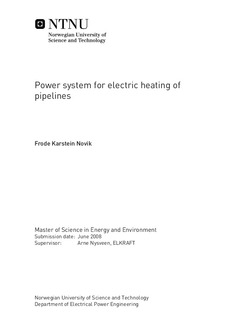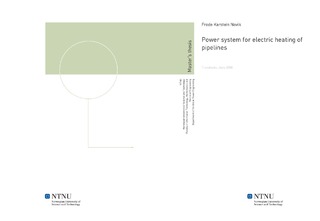| dc.description.abstract | Direct electrical heating (DEH) of pipelines is a flow assurance method that has proven to be a good and reliable solution for preventing the formation of hydrates and wax in multiphase flow lines. The technology is installed on several pipelines in the North Sea and has become StatoilHydros preferred method for flow assurance. Tyrihans is the newest installation with 10 MW DEH for a 43 km pipline. However, the pipeline represents a considerable single-phase load which makes the power system dependent on a balancing unit for providing symmetrical conditions. This limits the step out distance and is not suitable for subsea installation. Aker Solutions has proposed several specially connected transformers for subsea power supply of DEH systems, Scott-T being one of them. The Scott-T transformer is a three-to-two-phase transformer which provides balanced electrical power between the two systems when the two secondary one-phase loads are equal. By implementing this transformer, it can be possible to install the power supply subsea as there is no need for a balancing unit. In addition, the system may be applicable for long step out distances. This is because the pipeline is inductive and can use the reactive power produced by the long cable which also can increase the critical cable length. There are however some limitations on this system using the Scott-T transformer. There is a large variation in the magnetic permeability between individual joints of the pipeline. This can result in different load impedance of the two pipe sections connected to the Scott-T transformer. The result is unbalance in the power system. The method of symmetrical components is applied to investigate the behavior during unbalanced loading of the Scott-transformer. The relationship between the negative- and the positive sequence component of the current is used to express the degree of unsymmetry. For the simulations in SIMPOW, the Scott-T transformer is modelled by the use of Dynamic Simulation Language. The simulations on the DSL model give correct and reliable results for analysing the the degree of unsymmetry in the Scott-T transformer. When the load impedance of one pipe section is varied, simulation proves that it can change between 0.75 and 1.34 per unit of the other pipe impedance. The Scott-T transformer does still provide electrical power between the two systems which is below the limit for the degree of unsymmetry (15%). Case 1 and Case 2 introduce two possible configurations for a subsea DEH system with the Scott-T transformer implemented. The configurations include an onshore power supply which is connected to a subsea power system for direct electrical heating and a subsea load at the far end of the subsea cable. The pipeline in Case 1 is 100 km long and is divided into two pipe sections of 50 km which are connected to a Scott-T transformer. The pipeline in Case 2 is 200 km long and is divided into four pipe sections of 50 km each. There are two Scott-T transformers in Case 2. For normal operation of the subsea load (50 MW, cosfi=0.9) and heating the pipe content from the ambient sea emperature, the results indicate that tap changers are necessary to keep the Scott-T transformers secondary terminal voltage at 25 kV. This meets the requirement in both cases for heating the pipe content from 4 to 25 degrees celsius within 48 hours after a shutdown of the process. The degree of unsymmetry is zero for both cases when the system is operated as normal. However, all system simulations indicate that reactive power compensation has to be included for Case 1 as well as for Case 2 in order to have a power factor of unity at the onshore grid connection. The fault scenarios indicate that the degree of unsymmetry is dependent on both the type of fault and the power supply in the system. For Case 1, the relationship (I-/I+) is only of 3.3% in the subsea cable when there is a short-circuit at DEHBUS3, but as much as 87% at the grid connection. The degree of unsymmetry in the Scott-T transformer is then 67%. This is far beyond the limit for maximum negative sequence component of 15%. The significant unsymmetry in the line between the grid and BUS1 is most likely due to the large power delivered to the fault. During the fault, the reactive power delivered to the system increases from 10.6 Mvar to 131.9 Mvar after the fault, but the active power increases only from 75.2 MW to 87.1 MW. This means that it is most likely the reactive power that contributes to the consequent unsymmetry and negative sequence component of the current. There are two Scott-T transformers installed in Case 2. If the DEH system is only heating the pipe section closest to shore (at DEHBUS33), simulations show that the three-phase power system becomes unsymmetric which results in different phase currents. The degree of unsymmetry at the grid connection is 32% when only the pipe section at DEHBUS33 is heated. In addition, the unbalance in the three-phase system caused by SCOTT1 involves unbalance in the SCOTT2 transformer as well. The load voltages are not equal in magnitude and dephased of 90 degrees for this mode, but are 32 kV and 35 kV respectively and dephased of 88 degrees. This concludes a very important behavior of the Scott-T transformer. The simulations conclude that the Scott-T transformer provides symmetrical conditions for both configurations when the two load impedances are equal. However, Case 2 shows an important result when installing two Scott-T transformers in the same system. Unbalanced loading of one of the specially connected transformers gives unsymmetrical conditions in the three-phase system which results in unbalanced load voltages for the other Scott-T transformer. The analysis is limited to the configurations given for Case 1 and Case 2, but shows typical results when an alternative transformer connection is implemented in a DEH system. | nb_NO |

